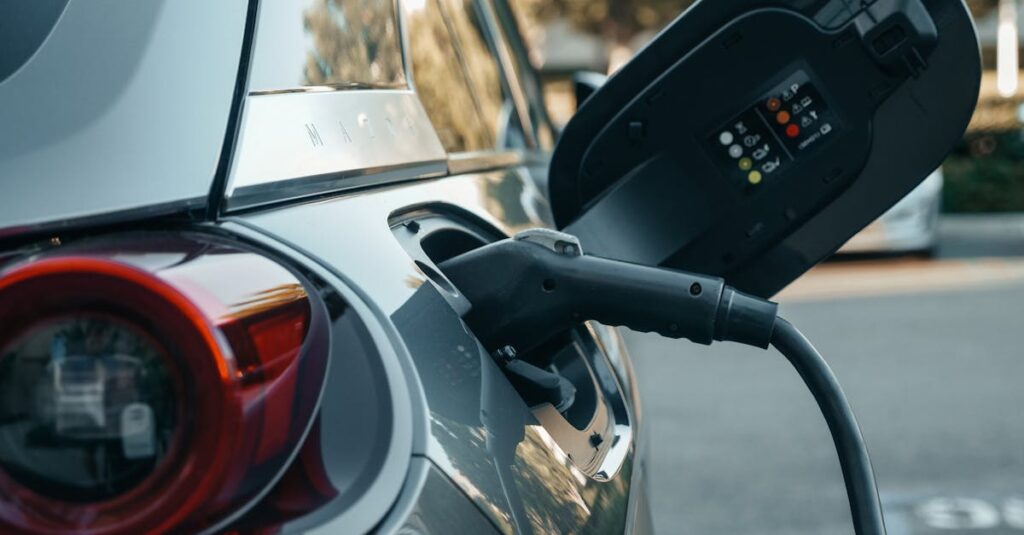Electric vehicles are revolutionizing the way we think about transportation, but not all charging options are created equal. Just like ordering a coffee, you’ve got your espresso shots, your lattes, and then there’s that mysterious decaf option lurking in the corner. When it comes to EV charging, understanding the differences between Level 1, Level 2, and Level 3 can feel just as confusing.
Table of Contents
ToggleOverview of EV Charging Levels
Electric vehicle (EV) charging occurs at three distinct levels, each varying in speed and application. Level 1 charging utilizes a standard household outlet, supplying 120 volts. This method generally delivers 4 to 5 miles of range per hour, making it ideal for overnight charging at home.
Level 2 charging employs a dedicated charging station and operates at 240 volts. This setup significantly enhances charging speed, providing 10 to 60 miles of range per hour, depending on the vehicle and charger. Level 2 stations are prevalent in public locations, including shopping centers and workplaces, facilitating convenient charging during daily errands.
Level 3 charging, also known as DC fast charging, uses powerful chargers that provide high voltage, typically between 400 to 800 volts. This charging level can recharge an EV to 80% in less than 30 minutes, offering 100 to 200 miles of range depending on the vehicle model. DC fast chargers are usually located along highways, catering to long-distance travel needs.
Users should consider their charging habits when choosing an EV charging level. Level 1 suits those with ample time for overnight charging, while Level 2 provides a balance of speed and accessibility for daily use. Level 3 serves drivers seeking rapid turnaround times.
Understanding these differences empowers EV users to select the suitable charging options for their lifestyles, enhancing the overall ownership experience. Accessing the right charging level at the right time makes owning an electric vehicle more manageable and efficient.
Level 1 Charging
Level 1 charging represents the most basic form of electric vehicle charging. It utilizes a standard household outlet for power.
Characteristics of Level 1 Charging
Charging occurs at 120 volts. This level delivers approximately 4 to 5 miles of range per hour, making it suitable for overnight charging. Typically, it requires a standard three-prong plug, allowing for easy setup in most locations. Convenience ranks high since drivers can plug in their EVs at home without needing special equipment. Its compatibility with any household circuit makes it widely accessible.
Advantages and Disadvantages
Cost-effectiveness stands out as a significant advantage. Level 1 charging often involves no installation expenses. Charging at home overnight can align well with drivers’ routines, making it an efficient choice for short commutes. Yet, waiting times can pose a drawback. Charging can take several hours to deliver a full charge, often unsuitable for longer trips. Limited range gained per hour means it might not satisfy the needs of drivers with extensive daily travels. Understanding these factors aids in decision-making regarding charging methods.
Level 2 Charging
Level 2 charging offers a more efficient alternative to Level 1, providing significantly quicker charging for electric vehicles. This charging method uses a dedicated 240-volt circuit, which allows for a more versatile range of charging options, both at home and in public locations.
Characteristics of Level 2 Charging
Level 2 charging stations deliver 10 to 60 miles of range per hour, making them suitable for daily use. These stations typically require a professional installation for home setups. Many public Level 2 chargers are available at shopping centers, workplaces, and parking garages. Operators can monitor charging progress via smartphone apps or dashboards. Fast charging availability makes Level 2 a practical choice for users needing a quick top-up during errands.
Advantages and Disadvantages
One primary advantage of Level 2 charging is its speed. It significantly reduces charging time compared to Level 1. Home installations enhance convenience, as drivers can charge overnight without frequent stops. Accessibility at numerous public locations increases options for urban EV owners. However, installation costs might be high for some users. Limited availability in certain rural areas can hinder access. Additionally, while faster than Level 1, Level 2 charging doesn’t match the speed of DC fast charging stations.
DC Fast Charging
DC fast charging represents the fastest option for recharging electric vehicles. Utilizing high voltages ranging from 400 to 800 volts, it delivers significant power in a short amount of time.
Characteristics of DC Fast Charging
DC fast charging stations provide 100 to 200 miles of range in under 30 minutes. Stations are typically found along highways, facilitating long-distance travel. This charging method employs direct current, enabling faster power delivery compared to Level 2 options. Most DC fast chargers use the CHAdeMO or CCS connectors, ensuring compatibility with various EV models. Power output often exceeds 50 kW, reaching up to 350 kW in some instances. Drivers benefit from a quick boost in charging sessions, making it an essential resource for road trips.
Advantages and Disadvantages
One major advantage of DC fast charging is the significantly reduced charging time. Convenience increases as drivers can quickly replenish their vehicles during long trips. Reduced range anxiety arises, allowing users to travel greater distances with confidence. However, installation costs for DC fast chargers can be high, which may hinder widespread availability. Not all EVs support fast charging, limiting options for some models. Additionally, faster charging can generate more heat, potentially affecting battery health over time. Balancing these factors helps users make informed decisions regarding their charging preferences.
Comparison of Charging Levels
Understanding the differences between EV charging levels helps users identify the most suitable options for their needs. Each level presents unique features that cater to various charging scenarios.
Charging Speed and Time
Charging speed varies significantly between the three levels. Level 1 provides 4 to 5 miles of range per hour, ideal for overnight home charging. In contrast, Level 2 charges an EV at a rate of 10 to 60 miles per hour, making it suitable for daily use, especially at workplaces and public locations. DC fast charging stands out with the ability to deliver 100 to 200 miles of range in under 30 minutes. This rapid charging capability supports long-distance travel, emphasizing the importance of selecting the appropriate level based on travel requirements.
Cost Considerations
Cost plays an essential role in choosing a charging level. Level 1 charging relies on existing household outlets, meaning no installation cost is needed. Level 2 charging necessitates a dedicated 240-volt circuit, which often incurs installation fees ranging from $500 to $2,000. While the initial investment is higher, the efficiency gained can make it worthwhile. DC fast charging infrastructure involves substantial setup costs and can also incur higher per-use fees due to its advanced technology. Evaluating the long-term savings and convenience will help determine the best option based on individual budgets.
Application Scenarios
Different charging levels suit various scenarios. Level 1 charging benefits individuals who primarily travel short distances and prefer home charging overnight. In urban settings, Level 2 charging becomes advantageous due to its faster rates, often located at workplaces and shopping centers. For drivers embarking on long road trips, DC fast charging stations provide convenient access along highways, accommodating the need for quick turnaround times. Understanding these application scenarios enables users to select the charging solutions that align best with their lifestyles and travel habits.
Understanding the differences in EV charging levels is crucial for optimizing the electric vehicle ownership experience. Each level offers unique advantages tailored to specific needs. Level 1 is perfect for those who charge overnight at home without the need for additional installations. Level 2 serves daily commuters well, providing faster charging at convenient locations. For long-distance travelers, Level 3 charging stations ensure rapid recharges, making road trips more feasible.
By recognizing these distinctions, EV users can make informed choices that align with their lifestyles and driving habits. This knowledge not only enhances convenience but also contributes to a more efficient and enjoyable electric vehicle journey.





